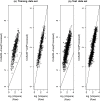Area and volumetric density estimation in processed full-field digital mammograms for risk assessment of breast cancer
- PMID: 25329322
- PMCID: PMC4203856
- DOI: 10.1371/journal.pone.0110690
Area and volumetric density estimation in processed full-field digital mammograms for risk assessment of breast cancer
Abstract
Introduction: Mammographic density, the white radiolucent part of a mammogram, is a marker of breast cancer risk and mammographic sensitivity. There are several means of measuring mammographic density, among which are area-based and volumetric-based approaches. Current volumetric methods use only unprocessed, raw mammograms, which is a problematic restriction since such raw mammograms are normally not stored. We describe fully automated methods for measuring both area and volumetric mammographic density from processed images.
Methods: The data set used in this study comprises raw and processed images of the same view from 1462 women. We developed two algorithms for processed images, an automated area-based approach (CASAM-Area) and a volumetric-based approach (CASAM-Vol). The latter method was based on training a random forest prediction model with image statistical features as predictors, against a volumetric measure, Volpara, for corresponding raw images. We contrast the three methods, CASAM-Area, CASAM-Vol and Volpara directly and in terms of association with breast cancer risk and a known genetic variant for mammographic density and breast cancer, rs10995190 in the gene ZNF365. Associations with breast cancer risk were evaluated using images from 47 breast cancer cases and 1011 control subjects. The genetic association analysis was based on 1011 control subjects.
Results: All three measures of mammographic density were associated with breast cancer risk and rs10995190 (p<0.025 for breast cancer risk and p<1 × 10(-6) for rs10995190). After adjusting for one of the measures there remained little or no evidence of residual association with the remaining density measures (p>0.10 for risk, p>0.03 for rs10995190).
Conclusions: Our results show that it is possible to obtain reliable automated measures of volumetric and area mammographic density from processed digital images. Area and volumetric measures of density on processed digital images performed similar in terms of risk and genetic association.
Conflict of interest statement
Figures


Similar articles
-
Evaluation of LIBRA Software for Fully Automated Mammographic Density Assessment in Breast Cancer Risk Prediction.Radiology. 2020 Jul;296(1):24-31. doi: 10.1148/radiol.2020192509. Epub 2020 May 12. Radiology. 2020. PMID: 32396041 Free PMC article.
-
Estimation of breast percent density in raw and processed full field digital mammography images via adaptive fuzzy c-means clustering and support vector machine segmentation.Med Phys. 2012 Aug;39(8):4903-17. doi: 10.1118/1.4736530. Med Phys. 2012. PMID: 22894417 Free PMC article.
-
Automated measurement of volumetric mammographic density: a tool for widespread breast cancer risk assessment.Cancer Epidemiol Biomarkers Prev. 2014 Sep;23(9):1764-72. doi: 10.1158/1055-9965.EPI-13-1219. Epub 2014 Jul 10. Cancer Epidemiol Biomarkers Prev. 2014. PMID: 25012995
-
Detection of potential microcalcification clusters using multivendor for-presentation digital mammograms for short-term breast cancer risk estimation.Med Phys. 2019 Apr;46(4):1938-1946. doi: 10.1002/mp.13450. Epub 2019 Mar 7. Med Phys. 2019. PMID: 30801718 Free PMC article. Review.
-
Analysis of mammographic density and breast cancer risk from digitized mammograms.Radiographics. 1998 Nov-Dec;18(6):1587-98. doi: 10.1148/radiographics.18.6.9821201. Radiographics. 1998. PMID: 9821201 Review.
Cited by
-
Potential Role of Zinc Finger 365 rs10822013 and rs10995190 in Mammographic Density, Sporadic Breast Cancer Risk, and Prognosis.Iran J Med Sci. 2023 Nov 1;48(6):551-562. doi: 10.30476/IJMS.2023.96141.2767. eCollection 2023 Nov. Iran J Med Sci. 2023. PMID: 38094285 Free PMC article.
-
E-Science technologies in a workflow for personalized medicine using cancer screening as a case study.J Am Med Inform Assoc. 2017 Sep 1;24(5):950-957. doi: 10.1093/jamia/ocx038. J Am Med Inform Assoc. 2017. PMID: 28444384 Free PMC article.
-
Breast Tissue Organisation and its Association with Breast Cancer Risk.Breast Cancer Res. 2017 Sep 6;19(1):103. doi: 10.1186/s13058-017-0894-6. Breast Cancer Res. 2017. PMID: 28877713 Free PMC article.
-
Overcoming challenges in conducting early phase breast cancer prevention trials: Bazedoxifene and conjugated estrogens vs waitlist control.Contemp Clin Trials. 2024 Nov;146:107697. doi: 10.1016/j.cct.2024.107697. Epub 2024 Sep 17. Contemp Clin Trials. 2024. PMID: 39293780
-
Subjective Versus Quantitative Methods of Assessing Breast Density.Diagnostics (Basel). 2020 May 21;10(5):331. doi: 10.3390/diagnostics10050331. Diagnostics (Basel). 2020. PMID: 32455552 Free PMC article.
References
-
- Boyd N, Martin L, Gunasekara A, Melnichouk O, Maudsley G, et al. (2009) Mammographic density and breast cancer risk: evaluation of a novel method of measuring breast tissue volumes. Cancer Epidemiol Biomarkers Prev 18: 1754–1762. - PubMed
-
- Byng JW, Boyd NF, Fishell E, Jong RA, Yaffe MJ (1994) The quantitative analysis of mammographic densities. Phys Med Biol 39: 1629–1638. - PubMed
Publication types
MeSH terms
Substances
LinkOut - more resources
Full Text Sources
Other Literature Sources
Medical

